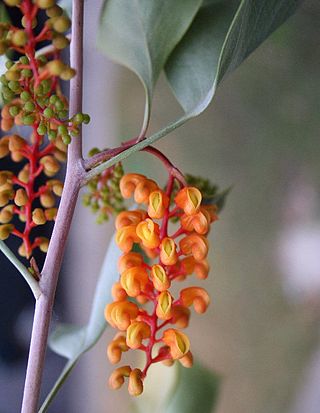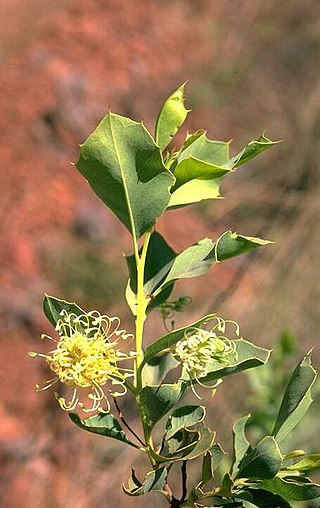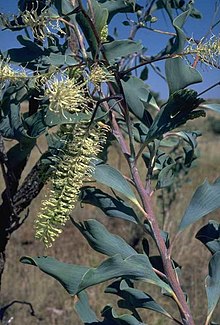
Grevillea wickhamii, commonly known as Wickham's grevillea, holly-leaf grevillea or lgarrmari in Djaru, is species of flowering plant in the family Proteaceae and is endemic to northern Australia. It is an erect shrub or spindly tree with holly-like, broadly egg-shaped leaves with 2 to 7 shallow teeth, and down-curved clusters of flowers, the colour depending on subspecies.

Grevillea miniata, commonly known as sandstone grevillea, is a species of flowering plant in the family Proteaceae and is endemic to north-western Australia. It is a spreading to erect shrub or small tree with more or less oblong leaves and bright yellow to orange and bright red flowers with a yellow style.

Grevillea hilliana, commonly known as white silky oak, white yiel yiel, Hill's silky oak and grey oak, is a species of flowering plant in the family Proteaceae and is endemic to eastern Australia. It is a tree with lance-shaped to oblong or lobed adult leaves and cylindrical clusters of large numbers of white to pale green flowers.

Grevillea agrifolia, the blue grevillea, is a species of flowering plant in the family Proteaceae and is native to the north of Western Australia and parts of the Northern Territory. It is a shrub or tree with narrowly oblong leaves with the narrower end towards the base, and creamy-yellow flowers.

Grevillea decurrens, also known as the clothes-peg tree, is a species of flowering plant in the family Proteaceae and is endemic to northern Australia. It is a shrub or tree with divided leaves, the lobes elliptic to egg-shaped with the narrower end towards the base, and conical groups of pink or cream-coloured flowers.

Grevillea maccutcheonii, commonly known as McCutcheon's grevillea, is a species of flowering plant in the family Proteaceae and is endemic to a single location in the south-west of Western Australia. It is a densely-branched shrub with three-lobed, stem-clasping leaves, and clusters of reddish-green flowers. The total population of the species was estimated in 2007 to be seven mature plants.

Grevillea byrnesii is a species of flowering plant in the family Proteaceae and is endemic to north-western Australia. It is a shrub with broadly egg-shaped leaves and orange flowers.

Grevillea stenobotrya is a shrub or small tree in the family Proteaceae that is endemic to arid regions of Australia. Common names include rattle-pod grevillea, sandhill grevillea, sandhill oak and sandhill spider flower.

Grevillea refracta, commonly known as silver-leaf grevillea, is a species of plant in the protea family and is native to northern Australia. It is a tree or shrub usually with pinnatipartite leaves and red and yellow flowers arranged on a branched, downcurved raceme.
Grevillea nematophylla, commonly known as water bush or silver-leaved water bush, is a species of flowering plant in the family Proteaceae and is endemic to Australia. It is shrub or small tree with simple or pinnatisect leaves, the leaves or lobes linear, and branched, cylindrical clusters of cream-coloured flowers.

Grevillea mimosoides, commonly known as caustic bush, is a species of flowering plant in the family Proteaceae and is endemic to northern Australia. It is a shrub or small tree with curved, narrowly elliptic or egg-shaped leaves and greenish-white to cream-coloured or pale yellow flowers.
Grevillea cunninghamii is a species of flowering plant in the family Proteaceae and is endemic to the north of Western Australia. It is a shrub with egg-shaped leaves with sharply-pointed teeth on the edges, and clusters of red flowers.

Grevillea dryandri is a species of flowering plant in the family Proteaceae and is endemic to northern Australia. It is a spreading to erect shrub with divided leaves with up to seventy or more linear to narrowly elliptic leaves, and long clusters of red, orange-red, pink or white flowers.

Grevillea brachystachya, commonly known as short-spiked grevillea, is a species of flowering plant in the family Proteaceae and is endemic to the south-west of Western Australia. It is a bushy shrub with linear leaves and more or less spherical clusters of cream-coloured to greenish flowers.

Grevillea erythroclada, commonly called needle-leaf grevillea, is a species of flowering plant in the family Proteaceae and is endemic to northern Australia. It is a shrub or small tree with divided leaves, the ultimate lobes linear to more or less cylindrical, and clusters of cream-coloured to pale yellow flowers.

Grevillea myosodes is a species of flowering plant in the family Proteaceae and is endemic to north-western Australia. It is a spreading shrub with elliptic leaves and branched clusters of cream-coloured flowers.

Grevillea prasina is a species of flowering plant in the family Proteaceae and is endemic to north-western Australia. It is a spreading or straggly shrub with egg-shaped to elliptic leaves with coarsely-toothed edges, and dense, cream-coloured to pale yellow flowers, the style pale green to white.

Grevillea pyramidalis, commonly known as the caustic bush, is a species of flowering plant in the family Proteaceae and is endemic to north-western Australia. It is an erect, spindly shrub or small tree with simple linear or pinnatisect leaves with linear to narrowly egg-shaped lobes, and white to yellow or cream-coloured flowers.

Grevillea velutinella is species of flowering plant in the family Proteaceae and is endemic to northern Western Australia. It is a shrub with broadly egg-shaped leaves in outline, sometimes with 2 to 7 teeth, and down-turned, often branched clusters of yellowish-green to lemon or cream-coloured flowers.
Gompholobium subulatum is a species of flowering plant in the pea family Fabaceae and is endemic to northern Australia. It is a slender, erect shrub with pinnate leaves with five to eleven leaflets, and uniformly yellow, pea-like flowers.


















